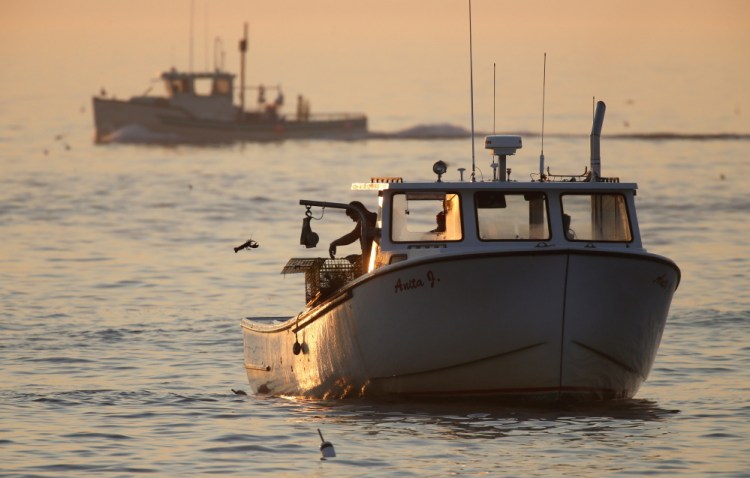The lobster population has crashed to the lowest levels on record in southern New England while climbing to heights never before seen in the cold waters off Maine and other northern reaches — a geographic shift that scientists attribute in large part to the warming of the ocean.
The trend is driving lobstermen in Connecticut and Rhode Island out of business, ending a centuries-old way of life.
Restaurant diners, supermarket shoppers and summer vacationers aren’t seeing much difference in price or availability, since the overall supply of lobsters is pretty much steady.
But because of the importance of lobsters to New England’s economy, history and identity, the northward shift stands as a particularly sad example of how climate change may be altering the natural range of many animals and plants.
“It’s a shame,” said Jason McNamee, chief of marine resource management for Rhode Island’s Division of Fish and Wildlife. “It’s such a traditional, historical fishery.”
In 2013, the number of adult lobsters in New England south of Cape Cod slid to about 10 million, just one-fifth the total in the late 1990s, according to a report issued this month by regulators. The lobster catch in the region sank to about 3.3 million pounds in 2013, from a peak of about 22 million in 1997.
The declines are “largely in response to adverse environmental conditions, including increasing water temperatures over the last 15 years,” along with continued fishing, the Atlantic States Marine Fisheries Commission said in a summary of the report.

Scott Beede returns an undersized lobster in this 2012 file photo while fishing in Mount Desert. Scientists attribute lower lobster numbers in southern New England in large part to the warming of the ocean. The Associated Press
At a power plant in Long Island Sound, for example, there were more than 75 days with a recorded average water temperature above 68 degrees Fahrenheit in 2012, 2013 and 2014, the report said. Between 1976 and 2010, that happened only twice.
In northern New England, meanwhile, lobsters are booming.
The population in the Gulf of Maine — a body of water that touches Canada, Maine, New Hampshire and the northern shore of Massachusetts — and in the Georges Bank fishing grounds farther out to sea has reached record highs, more than doubling to about 250 million adult lobsters since the mid-1990s, the report said.
Maine fishermen have landed more than 100 million pounds of lobster for four years in a row, by far the highest four-year haul in the state’s history.
“It very much looks like what you would expect from a species that is responding to a warming ocean: It’s going to move toward the poles,” said Andy Pershing, chief scientific officer for the Gulf of Maine Research Institute of Portland.
Seaside lobster bakes will probably continue to be the cornerstone of the summer for thousands of southern New England vacationers every year. But more and more of those lobsters will come from the north rather than local waters.
Robert Bradfield, a former Newport, Rhode Island, lobsterman, is among those who have gotten out of the business because of the declining catch.
Bradfield fondly recalls summer hauls in the 1990s when his traps would be bursting with up to 2,000 pounds of lobsters per day — catches he said had plummeted to maybe 100 pounds when he quit a decade ago. He now works on a pilot boat, transporting ship pilots to inbound and outbound vessels.
“It tore me apart to do something else,” said Bradfield, 60, who caught lobsters for 30 years. “Financially, it didn’t make sense for me anymore.”
Rhode Island issued 874 commercial lobster licenses in 2013, down from nearly 1,600 in 1998, and the number of lobster traps set by Rhode Island fishermen in southern New England waters has dropped by more than half since 2007 — signs that lobstermen are quitting. Connecticut, where the industry has cratered, was down to 18,435 traps in the area in 2013, compared with more than 160,000 in the late 1990s.
“The wheelhouse of the lobster fishery has shifted north,” said Dan McKiernan, deputy director of the Massachusetts Division of Marine Fisheries and chairman of the Atlantic States commission’s lobster management board.
How the commission will respond remains to be seen. It is still studying the issue.
John Hoenig, a professor at the Virginia Institute of Marine Science, said he doesn’t think anything short of a moratorium on lobstering will help save the southern New England lobster. That would make life even more difficult for those trying to make a living out of pulling up traps.
But others fear there is not a lot regulators can do because the problem appears largely environmental.
“We can’t control the water temperature,” lamented William Adler, a Massachusetts lobsterman and a member of the commission’s lobster management board.
Send questions/comments to the editors.



Comments are no longer available on this story